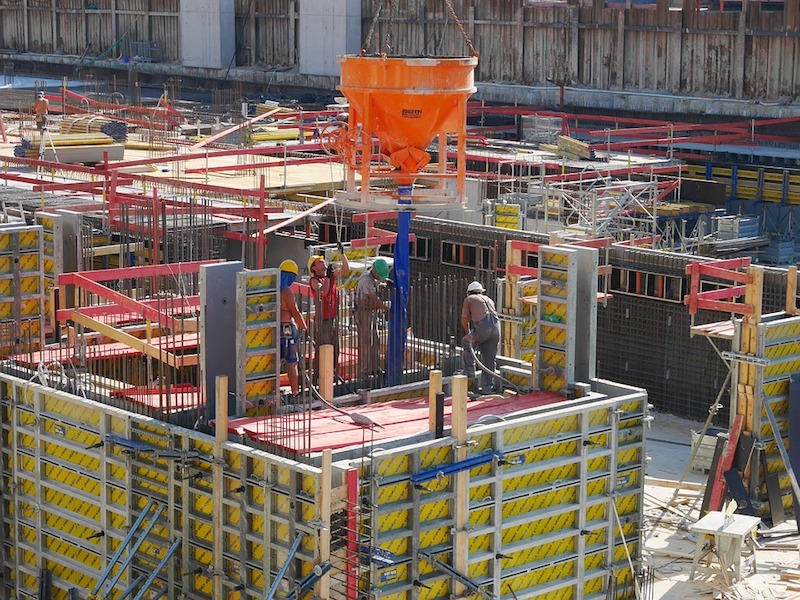Strong construction momentum will easily carry through the first half of 2019, despite project margins facing pressure from all sides. JLL’s Construction Outlook finds robust U.S. economic fundamentals will drive further growth of the sector, which in 2018 recorded a 5.1% increase in total construction value and a 4.5% increase in employment.
Potential risks to the construction sector such as trade war escalation, deteriorating macroeconomic conditions and the worsening labor shortage, are largely balanced by potential boosts that include a large-scale federal infrastructure package, relief from tariffs and the continuation of 3.5% annual GDP growth.
“All forward indicators for construction are still flashing green,” said Todd Burns, President, Project and Development Services, JLL Americas. “However, a year with growth equal to that of 2018 would be considered a success, given concerns of a broader economic slowdown.”
Rising construction costs will sideline select projects
Total building costs, which includes labor, materials and equipment, grew by 3.4% in 2018, outpacing the U.S. inflation rate of 1.9%. The widening spread between cost growth and inflation is pushing borderline projects past the threshold of profitability. Building costs will continue to increase in 2019 but at a slower rate than 2018. This reflects an expected cooldown in material pricing but the surging cost of labor.
Growth in total construction employment has hovered between 3 and 6% over the past six years – a far cry from what’s required for labor supply to catch up with demand. With a tight national employment market, the situation is unlikely to improve anytime soon. Construction wage growth in 2019 will top the 3.4% increase seen last year.
Trade policy a powerful “swing” force
With a direct impact on commodity prices, tariffs represent a uniquely immediate threat to an industry that typically moves slowly. Given the well-established political willingness to impose tariffs and the widening trade deficit with China, a continuation of tariffs in 2019 is expected.
The biggest chance for relief from tariffs are international trade deals that would lift tariffs in exchange for other trade or economic concessions. Such a deal could represent a dramatic positive for construction and is a potential bright spot for the industry.
Construction tech in growth mode, presents opportunity for labor shortage relief
The buzz around construction technology has long eclipsed actual adoption in the industry. The past year, however, saw meaningful gains fueled by large general contracting firms racing to improve productivity and remain competitive. High levels of tech adoption will spread to smaller firms, and elements of construction tech will become the standard across the industry in 2019. Amid intense labor pressures, contractors’ most common reason for making technology investments is to increase labor productivity.
Modular construction is poised to have the biggest long-term impact on the industry. Proponents of the technology envision a future full of dedicated warehouses churning out modular components – from exterior wall segments to entire apartment units – for most new construction.
“Adopting modular construction is not always as simple as it sounds,” said Henry D’Esposito, Senior Research Analyst, Project and Development Services, JLL. “There is often a prolonged period during which the benefits are not fully realized, as firms take time to adjust to the new system. Despite some of the initial challenges, there has been no hesitation among contractors about whether modular will continue to grow.”
Growth of modular construction in 2019 will be centered around increased use by select sectors, including hospitality and healthcare, and an increase in use for one or two select elements within a broader array of projects.
Related Stories
Market Data | Jul 19, 2021
Construction employment trails pre-pandemic level in 39 states
Supply chain challenges, rising materials prices undermine demand.
Market Data | Jul 15, 2021
Producer prices for construction materials and services soar 26% over 12 months
Contractors cope with supply hitches, weak demand.
Market Data | Jul 13, 2021
ABC’s Construction Backlog Indicator and Contractor Confidence Index rise in June
ABC’s Construction Confidence Index readings for sales, profit margins and staffing levels increased modestly in June.
Market Data | Jul 8, 2021
Encouraging construction cost trends are emerging
In its latest quarterly report, Rider Levett Bucknall states that contractors’ most critical choice will be selecting which building sectors to target.
Multifamily Housing | Jul 7, 2021
Make sure to get your multifamily amenities mix right
One of the hardest decisions multifamily developers and their design teams have to make is what mix of amenities they’re going to put into each project. A lot of squiggly factors go into that decision: the type of community, the geographic market, local recreation preferences, climate/weather conditions, physical parameters, and of course the budget. The permutations are mind-boggling.
Market Data | Jul 7, 2021
Construction employment declines by 7,000 in June
Nonresidential firms struggle to find workers and materials to complete projects.
Market Data | Jun 30, 2021
Construction employment in May trails pre-covid levels in 91 metro areas
Firms struggle to cope with materials, labor challenges.
Market Data | Jun 23, 2021
Construction employment declines in 40 states between April and May
Soaring material costs, supply-chain disruptions impede recovery.
Market Data | Jun 22, 2021
Architecture billings continue historic rebound
AIA’s Architecture Billings Index (ABI) score for May rose to 58.5 compared to 57.9 in April.
Market Data | Jun 17, 2021
Commercial construction contractors upbeat on outlook despite worsening material shortages, worker shortages
88% indicate difficulty in finding skilled workers; of those, 35% have turned down work because of it.

















